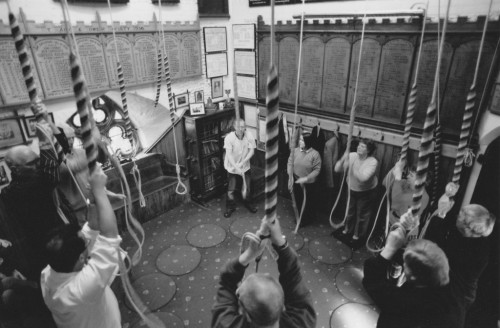Despite the curtailing of their liturgical uses, at the beginning of the seventeenth century a lot of church bells remained hanging in church towers. Ringing them was an activity pursued with great enthusiasm, often by groups of boozy young men. Paul Hentzner, a German lawyer who traveled through England in the final years of the sixteenth century, wrote that the English were “vastly fond of great noises that fill the ear, such as the firing of cannon, drums, and the ringing of bells, so that it is common for a number of them, that have got a glass in their heads, to go up into some belfry, and ring the bells for hours together for the sake of exercise.”
It was in these long, beer-fuelled ringing sessions that change ringing was invented, as a codification of the disorganized ringing that Hentzner describes. It seems to have started in London and southeast England in the early seventeenth century; it spread, and by the 1660s was a fashionable recreation, with societies springing up all over south, central, and eastern England to further the practice.
Change ringing operates on a simple but strict system of permutations. All the bells in a church tower are rung in rounds; each ringer rings a single bell, and the bells are hung such that the ringer is able to control the sound, making the bell strike once and only once per pull. Every bell must be rung once in each round, and the order in which the bells are rung (that is, the order of the round) may never be repeated. Change-ringing notation uses numbers, with each number standing for a bell.
If a ring of five bells starts ringing from highest bell to lowest, with 1 representing the highest bell and 5 the lowest, the first orderly round can be written as 12345. The following round might be 21345, then 23145, and so on; each new round is known as a change. The aim, in theory at least, is to exhaust all the possible orders in which the bells can be rung, without ever repeating a round; different ways of exhausting all the possible orders are known as “methods.” Strict rules govern which bells can swap places with which, and ringers developed a terminology—words all full of motion: bobs and dodges, hunts and “extream” changes—to describe the various ordered swaps the bells need to make so that they successfully exhaust the circuit and return to the original round, 12345.
Read more: Campanologomania — the fascinating history of church bell change ringing. Picture: St Mary le Tower.






